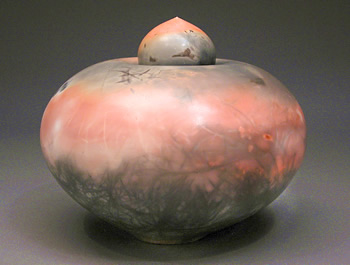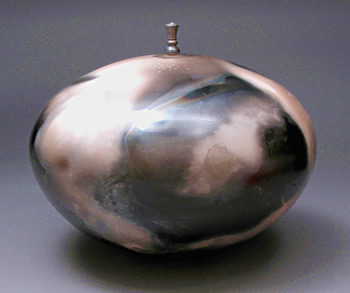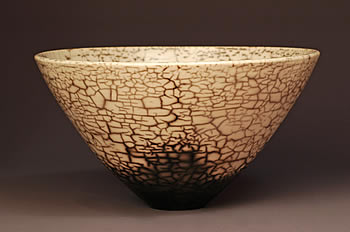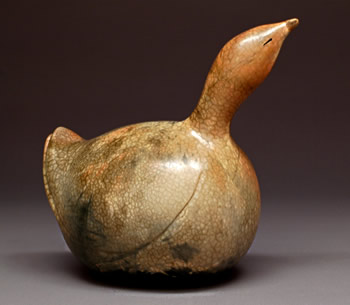Saggar Fired
 Saggar firing is a type of smoke-firing in which each pot is enclosed and fired in a lidded container.
Saggar firing is a type of smoke-firing in which each pot is enclosed and fired in a lidded container.
After throwing a pot, it is painstakingly burnished (smoothed) with a stone giving the surface a beautiful, silky glow that seems to come from within. The piece is allowed to dry completely, then several layers of a fine liquid clay called Terra Sigillata are applied and it is polished again after each coat. It is then fired to approx. 1000 degrees Centigrade and is ready to be saggar-fired.
The piece is then placed in a saggar (a two piece, thick-walled clay container) which has been individually thrown to fit the pot, along with some combustible materials such as sawdust, straw, seaweed, copper etc. The pots, nested in their saggars, are placed in a kiln and fired a second time. Many pieces are fired several times to achieve a desired surface effect, leaving the pots richly marked with visual texture, pattern, and a myriad of colours.
To protect the surface of the pots, they are given a light coating of wax and may be wiped with a damp cloth when necessary. These pieces are not designed to hold water.
Smoke Fired
 After throwing a pot, it is painstakingly burnished (smoothed) with a stone, giving the surface a beautiful, silky glow that seems to come from within. The piece is allowed to dry completely, then several layers of a fine liquid clay called Terra Sigillata are applied and it is polished after each coat. The piece is next fired in an electric kiln to approximately 1000 degrees Centigrade and ready to smoke-fire.
After throwing a pot, it is painstakingly burnished (smoothed) with a stone, giving the surface a beautiful, silky glow that seems to come from within. The piece is allowed to dry completely, then several layers of a fine liquid clay called Terra Sigillata are applied and it is polished after each coat. The piece is next fired in an electric kiln to approximately 1000 degrees Centigrade and ready to smoke-fire.
For the smoke firing the pot is placed in a metal or brick container, nested in a variety of kinds and textures of sawdusts and allowed to slowly smolder for several hours. The polished, unglazed surfaces become richly marked by the pattern of smoke and flame, imparting a soft earthiness and sensuality to the pieces. Many have been imprinted with a delicate leaf or fern 'shadow', using a special carbonization technique. No two are the same -- each piece is a surprise when taken from the kiln.
To protect the surface of the pots, they are given a light coat of wax and may be wiped with a damp cloth when necessary. These pieces are not designed to hold water.
Naked Raku
 Naked Raku is a variation derived from Western Raku firing techniques but differs in that these smoked pieces are unglazed.
Naked Raku is a variation derived from Western Raku firing techniques but differs in that these smoked pieces are unglazed.
Each piece is burnished (polished) after throwing which achieves a smooth, silky surface. It is allowed to dry completely and several layers of a fine, liquid slip called Terra Sigillata are applied and polished again after each coat. It is then fired to 950 degrees Centigrade. Following the initial firing, the piece is coated with a thick layer of slip, dried, then a crackle glaze layer is added. The slip acts as a barrier or "resist" layer which prevents the melted glaze from adhering to the piece so that the slip and glaze will separate from the clay surface after firing.
The piece is fired in a small propane kiln to 850 degrees Centigrade, removed from the kiln, "red-hot" and placed in a metal container with combustibles such as straw, sawdust or newspaper. The fracturing action of the slip and glaze layers, when penetrated by the smoke, leaves both striking and subtle patterns of dark, smoked lines on the white clay surface. Often, the pieces are fired several times to achieve a desired effect.
To protect the surface of the pots, each piece is given a light coating of wax and may be wiped with a damp cloth when necessary. These pots are not designed to hold water.
Birds
 I have always been fascinated by birds both big and small.
I have always been fascinated by birds both big and small.
Each day as I am working in my kitchen, I can look out at the birds that visit our feeders and enjoy their antics and the way they socialize with each other.
Often, when the birds are perched on a tree branch outside my kitchen window, I notice that I am being watched by them! I am particularly intrigued by crows with their quirky intelligence and prominent beaks.
My intention is not to create a life-like bird but a suggestion of a bird; to make people smile.
Each bird is one-of-a-kind. The body of the bird is thrown on the wheel, trimmed and a hand built head and tail are added. When the eyes and beak are in place, the bird seems to 'come to life', giving each one a 'spirit' and 'personality'. Finally, the birds are meticulously burnished (polished) and fired in a number of ways - smoke-fired, saggar-fired or naked raku fired.